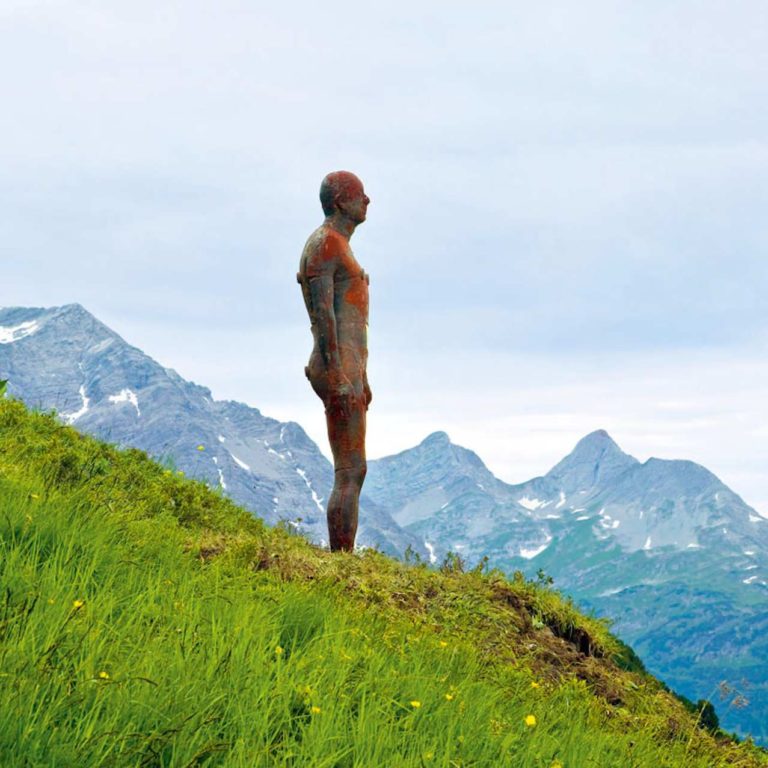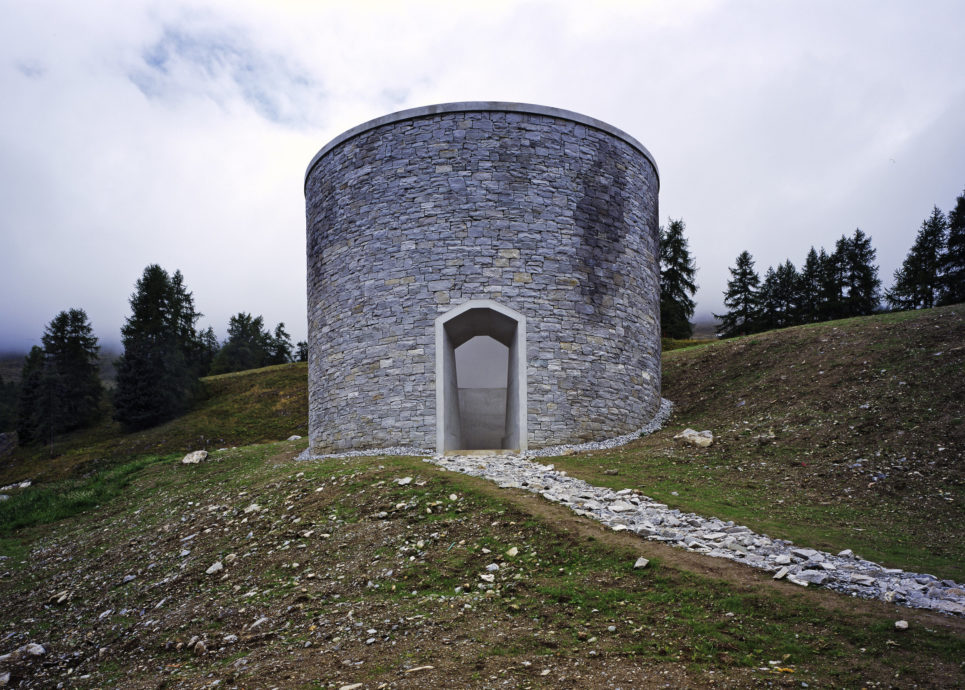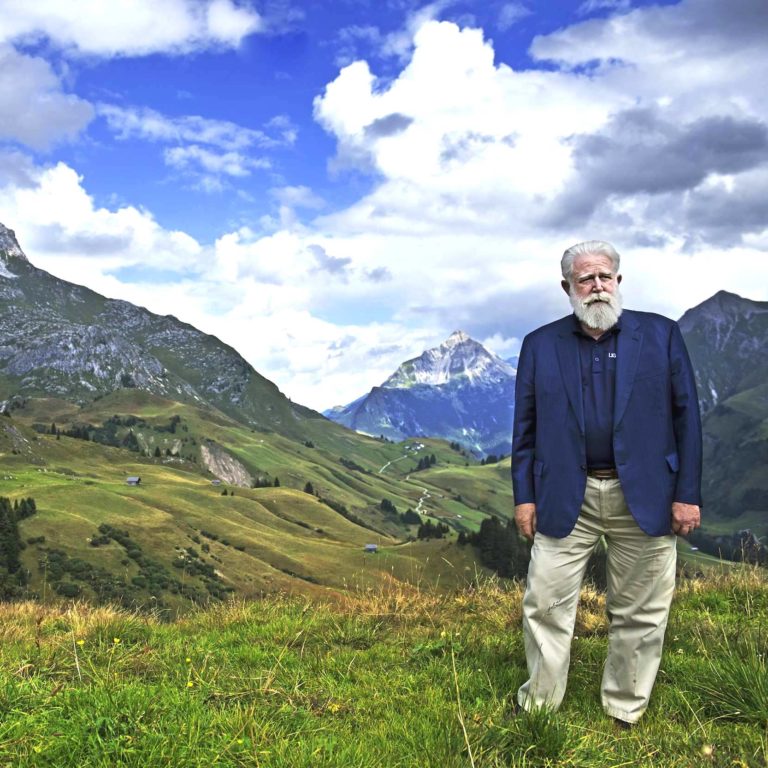


Rotunda: the “Piz Utor” Skyspace in Zuoz, Switzerland
Vista: sculpture from Horizon Field, the preceding project

C James Turrell realises one of his Skyspaces in Lech am Arlberg (c) Maria Muxel
James Turrell and his skyspace in Lech
It was during a hike around Lech am Arlberg that the worldfamous artist James Turrell was so taken by the mountains that one of his Skyspaces is now being realised precisely here – a space in which light is experienced anew
TEXT: THOMAS ZWICKER
The air up here is crystal clear and wonderfully fresh. A salutary tranquillity reigns above the Tannegg hill, a small, almost perfectly formed cone at an altitude of 1,780 metres above sea level, close to the Schlosskopf cable car high above Lech am Arlberg. All around, a powerful mountain landscape, with the Biberkopf, Karhorn, Mohnenfluh and Omeshorn towering heavenwards. In its isolation, the Tannegg appears rather as if it has been left behind in time, an energy location with an enchanting view where the hiker stops to pause for a moment. And which is set to soon act as the stage for one of the great works of art of our time.
Little light reaches here from the village, making it the perfect place for installing a Skyspace
He explains and points and shapes the planned project with his hands in such an enthusiastic, impassioned way that the work of art almost becomes visible. The tranquillity of the place, the contrast with the frequently turbulent hustle and bustle of the holiday season in Lech – both in summer and winter – are of major importance to Ludwig Muxel. “Culture is very, very important to us,” says the mayor. “Not only for the guests, but for us locals too.”
The large-scale “iron men” by Antony Gormley
were only the beginning
Culture in the lovely natural countryside around Lech Zürs am Arlberg has had its place for quite some time now. It was in 2010 that the Kunsthaus Bregenz realised a massive landscape installation known as “Horizon Field” with Antony Gormley, one of the most significant contemporary sculptors in Great Britain. Exactly 100 life-size iron figures were erected over an area of 150 square kilometres in the Lechquellengebiet of Vorarlberg, each at an altitude of 2,039 metres. They were complemented by maps of the locations, project descriptions, recommended hikes, talks and workshops. An art project in public space which, it may be said, caused an international sensation.
Gormley’s idea of integrating culture in nature was enthusiastically received – thousands of hikers and skiers came to admire the iron men in the mountains. According to their creator, the figures represent a “deep association between the social and the geological space, between landscape and memory.” Horizon Field, the art association established in Vorarlberg, logically set itself the objective of continuing the project originally intended to endin 2012 and to leave the 100 alpine sculptures as permanent installations. This plan failed, and almost all of the 640-kilogram heavyweights were taken down, and only one final iron man is still standing watch above the Kriegeralpe.
Since the locals of Vorarlberg are not known for their whining, but rather for their positive thinking and getting on with things, the association soon decided to launch a follow-up project with another internationally renowned artist. Working in cooperation with the local gallery owner Wolfgang Häusler (from Galerie Häusler Contemporary), the American light artist James Turrell was gained for the Skyspace venture in Lech. Under the management of doers such as Otto Huber (chairman) and Artur Vonblon (finances), the Horizon Field association came to an agreement with the landowners, obtained approvals, and worked on the finances. The Skyspace Lech project started to take shape.
Born in Los Angeles in 1943, initially James Turrell studied psychology and mathematics, and finished his studies in art in 1973. Since the 1960s, he has been working on so-called “light spaces” and, with this, has been examining the manifold manifestations of light, both natural and artificial. Installations and environments enable light to be experienced as an artistic medium, with area, colour and space entering into an electric interplay, making the light sensory, bringing it intellectually up-close. Since the 1970s, the artist has been working on his life’s work, the dormant volcano “Roden Crater” in Arizona with its tunnels, subterranean rooms and ceiling openings to the sky. In the form of his work “Aten Reign”, in 2013 he converted the Solomon R. Guggenheim Museum in New York into an atmospheric light space. This was followed by major retrospectives in the Los Angeles County Museum of Art (L ACMA) and the National Gallery of Australia. In total, Turrell has realised over 140 individual exhibitions in museums and galleries as well as over 60 Skyspaces worldwide.
We often look to the sky and think to ourselves how far away it is. Yet my Skyspaces lower the sky to the level of the ceiling of the room you find yourself in.
James Turrell isn’t an unknown in Vorarlberg: he illuminated the opening exhibition of the Kunsthaus Bregenz with his light installation in the façade back in 1997. It was at the invitation of the Horizon Field association that Turrell came to the mountains of Vorarlberg in September 2014, taking a hike to search for a suitable place for one of his Skyspaces, including to the Tannegg via Oberlech. The strapping man with a snow-white beard and bushy eyebrows was fascinated by this mountain landscape from the word go, soon acknowledging the Tannegg as a place excellently suited for a very special Skyspace. The artist quickly produced the first sketches for the project which is now being realised by the renowned Baumschlager-Eberle firm of architects with the objective of connecting landscape, nature and culture.
The Skyspaces by James Turrell are specially proportioned spaces into which the light falls via an opening in the ceiling. Some of them are integrated in existing buildings, some of them have been erected separately. “We often look to the sky and think to ourselves how far away it is. Yet my Skyspaces lower the sky to the level of the ceiling of the room you find yourself in,” according to the American. “Roden Crater”, the most spectacular of his projects to date, is a massive, dormant volcano close to Flagstaff in Arizona which Turrell has been turning into a gigantic light art project since 1974, in the form of shafts and tunnels cut into the volcano including openings directed towards the sky. There are currently 60 smaller Skyspace objects all over the world, and the work of art in Lech am Arlberg will fit in to the features of the village in the Alps.
Turrell’s plan intends on installing the work of art mainly underground, inside the peak. A tunnel 15 metres in length provides access to the oval-shaped main room which measures 6 x 9 metres, is 5.20 metres high and has space for approx. 30 visitors. The oval opening in the ceiling has a cupola which can be moved and, depending on the weather and the incidence of light, provides various perceptual effects. Phenomenal impressions are anticipated particularly at dusk. Additionally, three light installations generate variable colour moods.
What interests me is the effect of the light on you and your sense of perception
The Skyspace Lech will be hardly recognisable from the outside: great care is taken to perfectly integrate it in the surrounding nature. As a room of silence, as a space for slowing down and relaxing – it is already appreciated as these things. “What interests me is the effect of the light on you and your sense of perception,” the artist once said in an interview, adding, “you are flying through something that is almost fluid, the air turns into material, a brilliant, intensively glowing material.” If everything goes according to plan, locals and holiday-makers alike will be able to experience this mystical sensation in Lech before the end of 2017, following inauguration of the work of art.